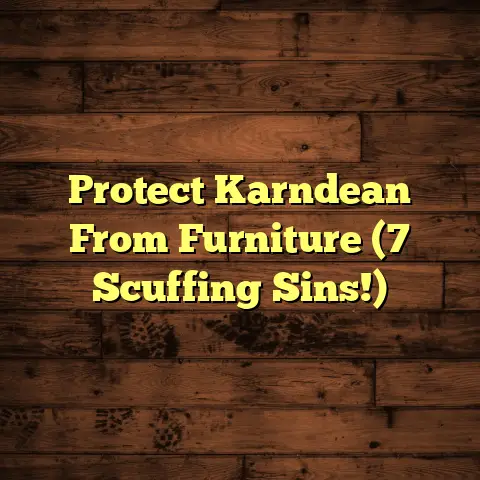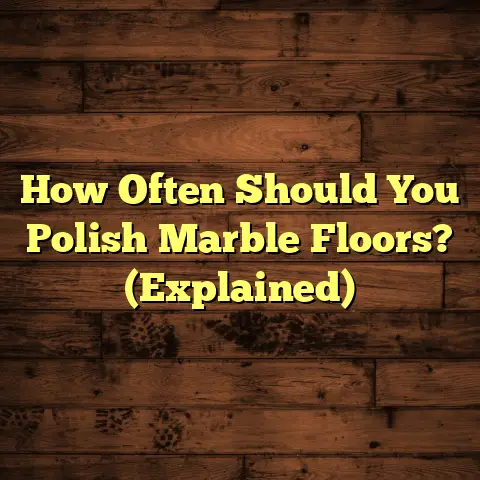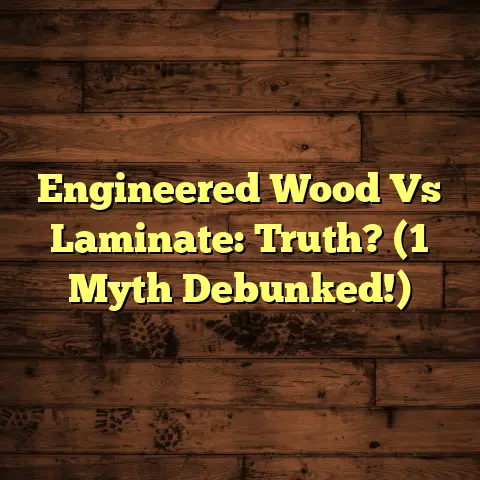Secure Plywood to Concrete? (3 Subfloor Secrets!)
I’m talking about the unsung hero, the foundation upon which all your flooring dreams are built: the subfloor.
And when that subfloor needs to be, say, plywood attached to concrete? That’s where things can get a little tricky.
I’m here to tell you, it’s absolutely critical.
It’s not just about slapping some wood down and hoping for the best. It’s about understanding the science, the materials, and the techniques that will ensure a lasting, squeak-free, and moisture-resistant floor.
In this article, I’m going to pull back the curtain and share three subfloor secrets that I’ve learned over years in the flooring business.
These aren’t just theoretical ideas. They’re the real-world strategies I use every single day to make sure my clients’ floors are rock solid.
So, grab a cup of coffee, and let’s dive into the fascinating world of plywood and concrete!
Understanding the Dynamics of Plywood and Concrete
Alright, let’s get down to brass tacks. Before we start slinging adhesive and wielding power tools, it’s crucial to understand the fundamental relationship between plywood and concrete.
The Science Behind Adhesion
Think of it like this: adhesion is all about getting two surfaces to play nice together.
Plywood, being wood, is porous and relatively flexible. Concrete, on the other hand, is dense, rigid, and, well, concrete.
The challenge is to find a way to create a strong, lasting bond between these two very different materials.
Adhesives work by creating a mechanical and/or chemical bond.
Mechanical bonding involves the adhesive seeping into the pores of both surfaces and then hardening, creating a physical interlock.
Chemical bonding involves the adhesive reacting with the surfaces at a molecular level, creating a much stronger and more durable connection.
The key is to choose an adhesive that’s specifically designed for bonding wood to concrete and to prepare the surfaces properly so that the adhesive can do its job effectively.
Moisture and Its Impact
Now, let’s talk about the elephant in the room: moisture. Concrete is notorious for its ability to hold moisture, and plywood is highly susceptible to it.
When moisture gets trapped between the plywood and the concrete, it can wreak havoc.
It can weaken the adhesive bond, leading to delamination (where the plywood separates from the concrete).
It can cause the plywood to warp, swell, or even rot. And, worst of all, it can create a breeding ground for mold and mildew, which can be a serious health hazard.
I’ve seen countless flooring projects ruined by moisture issues. Trust me, it’s not something you want to mess with.
How do you know if your concrete slab has moisture issues? A simple test is to tape a square of plastic sheeting (like a garbage bag piece) to the concrete floor with duct tape and leave it for 24 hours.
If you lift the plastic and see moisture on the plastic or the concrete is darker where the plastic was, you have a moisture problem.
Importance of Vapor Barriers
That’s where vapor barriers come in. A vapor barrier is a material that’s designed to prevent moisture from migrating from the concrete into the plywood.
It’s like a raincoat for your subfloor.
There are several types of vapor barriers available, including polyethylene film, asphalt-saturated felt, and specialized liquid-applied membranes.
I typically recommend using a polyethylene film that is at least 6 mil thick.
It’s relatively inexpensive, easy to install, and provides excellent moisture protection.
To install a polyethylene vapor barrier, simply roll it out over the concrete slab, overlapping the seams by at least 6 inches.
Tape the seams with a moisture-resistant tape to create a continuous barrier.
Extend the vapor barrier up the walls a few inches and tape it in place. This will prevent moisture from wicking up from the walls into the plywood.
The Three Secrets to Securing Plywood to Concrete
Alright, now that we’ve laid the groundwork (pun intended!), let’s get to the meat of the matter: the three secrets to securing plywood to concrete.
Secret #1: The Right Adhesive
Choosing the right adhesive is absolutely crucial. It’s the glue that holds everything together, so you can’t afford to skimp on quality or choose the wrong type.
Here are some of the most common types of adhesives used for bonding plywood to concrete:
-
Construction Adhesive: This is a general-purpose adhesive that’s readily available at most hardware stores. It’s relatively inexpensive and easy to apply, but it’s not the strongest option. I typically use it for smaller projects or when I need a quick fix.
-
Epoxy: Epoxy is a two-part adhesive that’s known for its exceptional strength and durability. It’s more expensive than construction adhesive, but it’s worth the investment if you need a really strong bond. Epoxy is also water-resistant, making it a good choice for areas that are prone to moisture.
-
Polyurethane Adhesive: Polyurethane adhesive is another excellent option for bonding plywood to concrete. It’s very strong, flexible, and water-resistant. It also has excellent gap-filling properties, which means it can fill in small imperfections in the concrete surface.
Here’s a simple table summarizing the pros and cons:
| Adhesive Type | Pros | Cons |
|---|---|---|
| Construction | Inexpensive, readily available, easy to apply | Not the strongest, may not be water-resistant |
| Epoxy | Very strong, durable, water-resistant | More expensive, requires mixing, can be brittle |
| Polyurethane | Strong, flexible, water-resistant, gap-filling | More expensive than construction adhesive, can be messy to apply |
Step-by-Step Guide to Applying Adhesive
- Clean the Concrete: Make sure the concrete surface is clean, dry, and free of any dust, dirt, or debris.
- Apply Adhesive: Apply the adhesive to the concrete using a notched trowel. The size of the notch will depend on the type of adhesive you’re using. Follow the manufacturer’s instructions.
- Lay Plywood: Carefully lay the plywood sheets onto the adhesive, making sure they’re properly aligned.
- Weight it down: Weigh down the plywood sheets with sandbags or other heavy objects to ensure good contact with the adhesive.
- Cure: Allow the adhesive to cure for the amount of time recommended by the manufacturer.
Secret #2: Proper Preparation of Surfaces
Surface preparation is like the foreplay of flooring. You can’t skip it and expect a satisfying result.
Cleaning the Concrete
Start by sweeping the concrete thoroughly to remove any loose debris. Then, use a concrete cleaner and a scrub brush to remove any dirt, oil, or grease.
If there are any stubborn stains, you may need to use a stronger cleaner or even a concrete grinder.
Leveling the Concrete
If the concrete surface is uneven, you’ll need to level it before installing the plywood.
This can be done using a self-leveling concrete compound. Simply pour the compound onto the concrete and spread it around with a trowel.
The compound will flow into the low spots and create a smooth, level surface.
Priming the Concrete
Priming the concrete is like putting on a base coat of paint. It helps the adhesive bond to the concrete more effectively.
Use a concrete primer that’s specifically designed for use with the adhesive you’re using.
Apply the primer to the concrete using a brush or roller. Allow it to dry completely before applying the adhesive.
Secret #3: The Installation Technique
Okay, you’ve got your adhesive, your surfaces are prepped, now it’s time to lay down that plywood!
Layout and Spacing
Before you start laying down the plywood, take some time to plan out your layout.
You want to make sure that the plywood sheets are properly aligned and that there are no gaps between them.
I typically recommend leaving a small gap (about 1/8 inch) between the plywood sheets to allow for expansion and contraction.
This will prevent the plywood from buckling or warping over time.
Screws vs. Nails
When it comes to fastening the plywood to the concrete, screws are generally a better choice than nails.
Screws provide a much stronger and more secure hold. They’re also less likely to loosen over time.
I recommend using concrete screws that are specifically designed for fastening wood to concrete.
These screws have a special thread that bites into the concrete and provides a very strong hold.
Avoiding Common Pitfalls
- Don’t Over-Apply Adhesive: Too much adhesive can actually weaken the bond. Apply a thin, even layer of adhesive to the concrete.
- Don’t Rush the Cure Time: Allow the adhesive to cure for the amount of time recommended by the manufacturer. Rushing the cure time can weaken the bond.
- Don’t Forget the Vapor Barrier: I can’t stress this enough. A vapor barrier is essential for preventing moisture problems.
Troubleshooting Common Issues
Even with the best preparation and techniques, you may still encounter some issues when securing plywood to concrete.
Here are some of the most common problems and how to fix them:
- Squeaking: Squeaking is often caused by the plywood rubbing against the concrete or against other plywood sheets. To fix squeaking, try injecting some adhesive into the gaps between the plywood and the concrete. You can also try shimming the plywood to eliminate any movement.
- Movement: If the plywood is moving or shifting, it means that the bond between the plywood and the concrete is not strong enough. Try adding more screws to secure the plywood to the concrete. You may also need to remove the plywood and reapply the adhesive.
- Moisture Damage: Moisture damage is a serious problem that can lead to rot, mold, and structural damage. If you suspect moisture damage, you’ll need to remove the plywood and inspect the concrete for moisture. If the concrete is wet, you’ll need to dry it out before installing new plywood. You may also need to install a new vapor barrier.
I remember one time I was working on a project where the homeowner had tried to install plywood over a concrete slab without a vapor barrier.
Within a few months, the plywood had started to warp and rot, and there was a terrible mold problem.
We had to tear out the entire floor and start over. It was a costly and time-consuming mistake that could have been easily avoided by simply installing a vapor barrier.
Here’s a quick table of common issues and solutions:
| Issue | Possible Cause | Solution |
|---|---|---|
| Squeaking | Plywood rubbing against concrete or other plywood sheets | Inject adhesive into gaps, shim the plywood |
| Movement | Weak bond | Add more screws, remove and reapply adhesive |
| Moisture Damage | Lack of vapor barrier, water intrusion | Remove damaged plywood, dry concrete, install new vapor barrier, replace plywood |
The Foundation of Your Flooring Success
So there you have it: the three secrets to securing plywood to concrete.
- Choose the right adhesive.
- Prepare the surfaces properly.
- Use the correct installation technique.
By following these simple steps, you can ensure that your flooring project is a success.
Remember, the subfloor is the foundation of your entire flooring system.
If it’s not solid, nothing else will be either.
Take the time to do it right, and you’ll be rewarded with a beautiful, durable, and long-lasting floor that you can enjoy for years to come.
I hope this article has been helpful.
If you have any questions or comments, please feel free to leave them below.
And as always, happy flooring!





